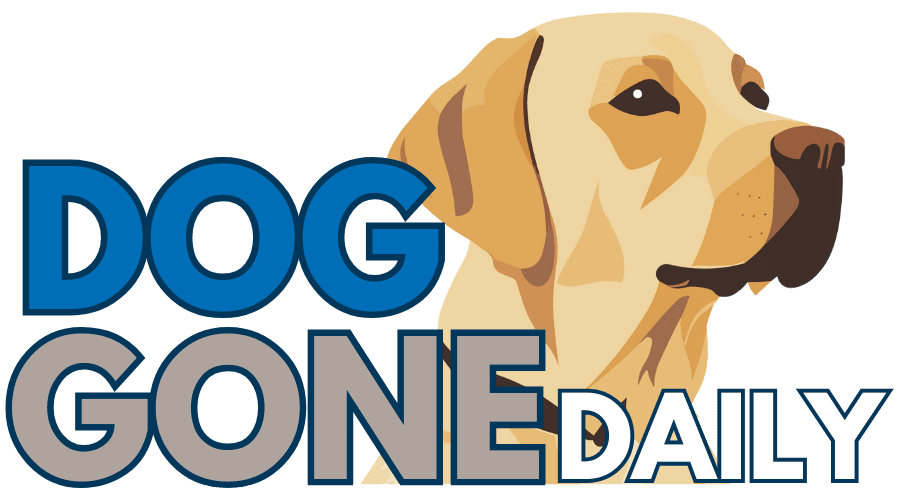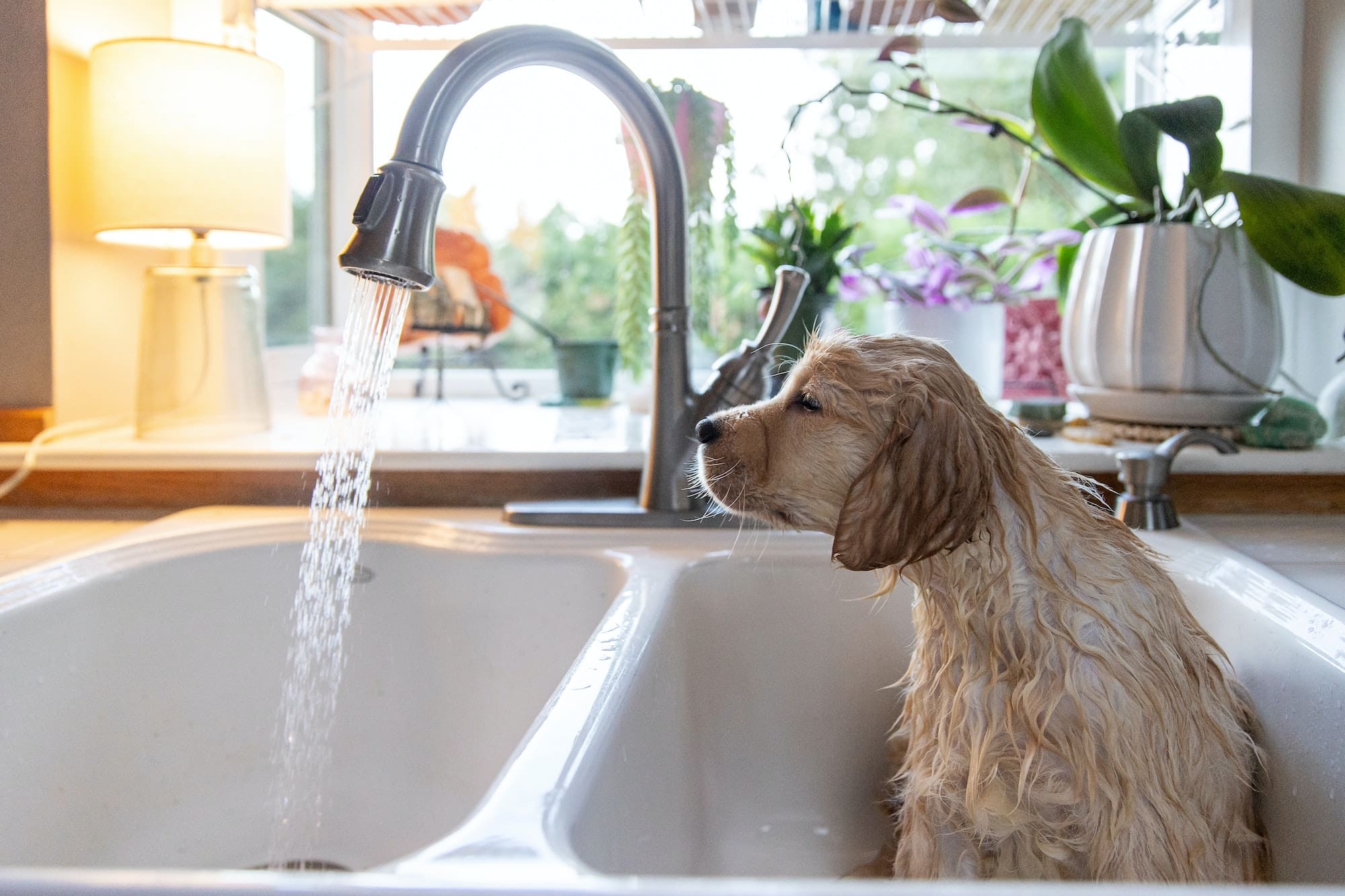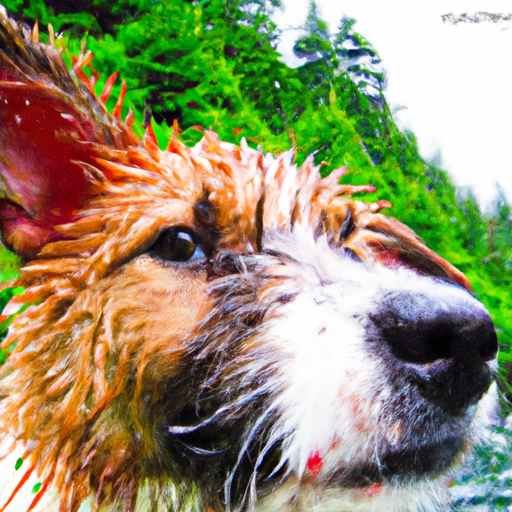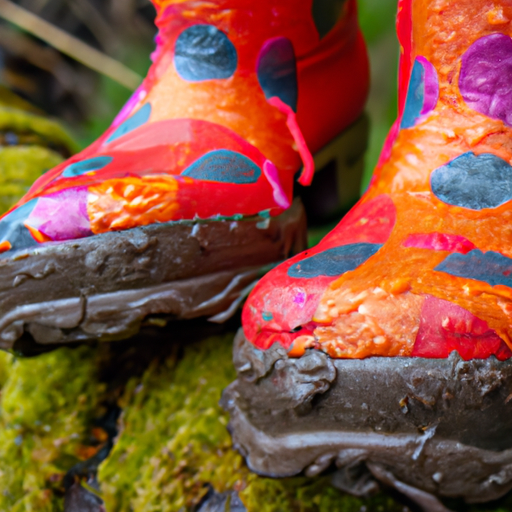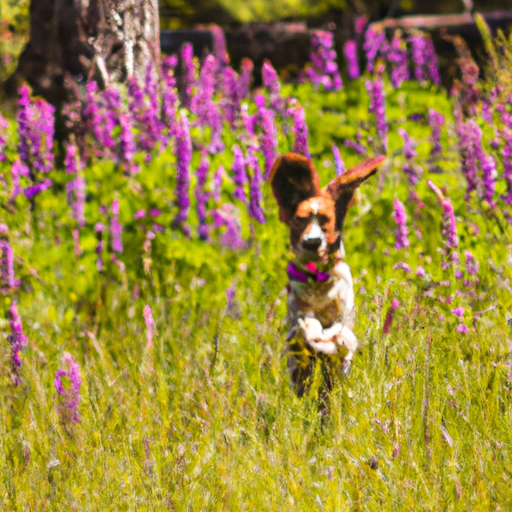Whether you're a seasoned dog owner or embarking on a new furry adventure, keeping your pup clean and well-groomed is an essential part of their overall health and happiness. In this article, we will explore the basics of puppy grooming, focusing specifically on the important tasks of brushing and bathing. From choosing the right tools to establishing a positive grooming routine, we'll provide you with all the information you need to make sure your little furball stays fresh and fabulous. So grab your brush, roll up your sleeves, and let's dive into the world of puppy grooming 101!
Choosing the Right Tools
When it comes to grooming your puppy, having the right tools is essential. Each puppy's coat is unique, so it's important to understand your puppy's coat type before selecting the appropriate tools.
Understanding Your Puppy's Coat Type
Puppies can have a variety of coat types, such as smooth, short, long, wavy, curly, or double coats. Different coat types require different grooming techniques and tools. For example, a smooth or short coat may only require a simple brush, while a curly or long coat may benefit from a combination of brushes and combs.
To determine your puppy's coat type, observe its fur. Is it dense or thin? Does it shed a lot or only occasionally? Understanding these characteristics will help you choose the right tools for grooming your puppy effectively.
Different Types of Brushes and Combs
There is a wide range of brushes and combs available for grooming puppies. Here are some common types and their purposes:
- Slicker brush: Ideal for removing loose fur and tangles in medium to long coats.
- Bristle brush: Suitable for smoothing and distributing natural oils in the coat.
- Pin brush: Great for gently untangling knots in long or curly coats.
- Undercoat rake: Designed to remove loose and dead hair from double-coated breeds.
- Comb: Useful for detangling and smoothing the fur, especially in matted areas.
Consider your puppy's coat type and consult with a professional groomer or veterinarian to determine the most appropriate brushes and combs for your furry friend's grooming needs.
Finding the Right Shampoo and Conditioner
Choosing the right shampoo and conditioner is crucial for maintaining your puppy's coat health. It's essential to use products that are specifically formulated for puppies. Regular human shampoos can be too harsh for their sensitive skin, potentially causing irritation or dryness.
Look for gentle, puppy-friendly shampoos that are free from harsh chemicals or fragrances. A mild, hypoallergenic shampoo will help keep your puppy's coat clean without stripping away natural oils.
Additionally, using a puppy conditioner will help keep the coat soft and manageable. Look for a conditioner that is specifically designed for puppies and follow the instructions for proper application.
Preparing Your Puppy for Grooming
Introducing your puppy to grooming from an early age is important to make the experience positive and stress-free. By taking the time to prepare your puppy for grooming, you can create a calm and enjoyable environment for both of you.
Introducing Your Puppy to Brushing
Start by gently introducing your puppy to the brush. Allow them to sniff and investigate the brush before slowly brushing them in a calm and reassuring manner. Gradually increase the duration of the brushing sessions over time as your puppy becomes more comfortable.
Be patient and reward your puppy with treats, praise, or playtime during and after the grooming sessions. This positive reinforcement will help associate grooming with pleasant experiences, making future sessions easier.
Creating a Positive Grooming Environment
Creating a positive grooming environment is crucial for your puppy's comfort and cooperation during grooming sessions. Choose a quiet and well-lit area where you can groom your puppy without distractions.
Ensure that the grooming area is comfortable and safe. Use a non-slip mat or table to prevent your puppy from slipping or falling during grooming. Place treats or toys nearby to provide positive distractions and keep your puppy engaged.
Handling Your Puppy with Care
During grooming, it's important to handle your puppy with care to prevent any unnecessary discomfort or stress. Use gentle and firm yet soothing movements, avoiding any sudden or rough actions that could startle your puppy.
If your puppy shows signs of distress or discomfort, take a break and provide reassurances. Remember to be patient and understanding, as grooming is a new experience for your puppy, and it may take time for them to adjust.
Brushing Techniques
Brushing your puppy's coat properly is essential for maintaining its health and appearance. The following techniques will help you groom your puppy effectively and prevent any potential coat issues.
Detangling Knots and Mats
Before brushing, carefully assess your puppy's coat for any knots or mats. Use your fingers or a detangling spray to gently separate the tangled hair. Start from the ends of the hair and work your way up to avoid causing discomfort or pain.
For more stubborn knots or mats, use a dematting comb or rake to carefully loosen the hair. Take your time and be patient, ensuring that you don't pull or tug too forcefully.
Brushing in the Right Direction
When brushing your puppy's coat, it's important to brush in the direction of hair growth. This helps to remove loose fur, distribute natural oils, and maintain the coat's overall appearance.
Use long, sweeping strokes, applying gentle pressure along the body. Use your free hand to hold the skin taut and prevent any discomfort to your puppy.
Using Gentle Pressure
While brushing, it's crucial to use gentle pressure to avoid causing any discomfort or skin irritation. Applying too much pressure can pull or tug on the fur, potentially hurting your puppy.
Remember to brush with a light touch, allowing the brush or comb to glide smoothly through the coat. Take breaks if necessary to avoid fatigue, ensuring that your puppy remains comfortable throughout the grooming session.
Brushing Different Areas of Your Puppy's Body
Different areas of your puppy's body require different brushing techniques. Here are a few tips to help you groom specific areas effectively:
- Tail and hindquarters: Use a slicker brush or comb to gently brush through and detangle the fur, paying attention to the base of the tail where mats can form.
- Belly and chest: Brush the belly and chest area using long, gentle strokes. Be cautious around sensitive areas and use a light touch to prevent any discomfort.
- Ears: Gently brush the ears with a soft-bristled brush or wipe them clean with a damp cloth. Take care not to apply too much pressure on this delicate area.
- Face and head: Use a soft brush or a grooming wipe to clean and brush around the face and head. Be particularly careful around the eyes, nose, and mouth.
By employing these techniques, you can ensure that your puppy's coat is well-maintained, healthy, and free from knots or mats.
Bathing Your Puppy
Regular bathing is an essential part of your puppy's grooming routine. However, bathing should be done carefully to ensure your puppy's comfort and prevent any skin irritation.
Choosing the Right Time and Place
Selecting the right time and place to bathe your puppy is crucial for a successful grooming experience. Choose a warm day or a time when your puppy is calm and relaxed.
Find a suitable bathing area, such as a bathtub or a sink. Place a non-slip mat or towel at the bottom to prevent your puppy from slipping.
Gathering the Necessary Supplies
Before bathing your puppy, gather all the necessary supplies to ensure a smooth and efficient process. Here are some essential items you'll need:
- Puppy-friendly shampoo and conditioner
- Towels or a soft washcloth for drying
- A handheld showerhead or a pitcher for rinsing
- Cotton balls for protecting the ears from water
- Treats or toys for positive reinforcement
- A grooming brush or comb
Having these supplies readily available will help you stay organized and focused during the bathing process.
Wetting and Soaping Your Puppy
Start by wetting your puppy's coat thoroughly with warm (not hot) water. Use a handheld showerhead or a pitcher to gently wet the fur, taking care to avoid getting water into your puppy's eyes or ears.
Next, apply a small amount of puppy-friendly shampoo, working it into a gentle lather. Begin at the neck and work your way down to the tail, massaging the shampoo into the coat. Take care to avoid the face and ears, as these areas require special attention.
Rinsing and Towel Drying
Once the shampoo is thoroughly applied, rinse your puppy's coat with warm water until all the soap residue is removed. Be thorough in your rinsing to prevent any skin irritation.
After rinsing, use a soft towel to gently pat your puppy dry. Avoid vigorous rubbing, as this can tangle or damage the fur. If your puppy has a longer coat, you may need to use additional towels or a hairdryer on the lowest heat setting to ensure complete drying.
Remember to provide positive reinforcement throughout the bathing process by offering treats, praise, and playtime. This will help your puppy associate bathing with positive experiences, making future sessions more enjoyable.
Avoiding Common Grooming Mistakes
While grooming your puppy, it's important to be aware of common mistakes that could potentially harm your furry friend. By avoiding these mistakes, you can ensure that your puppy's grooming experience is safe and enjoyable.
Overbrushing or Overwashing
Overbrushing or overwashing can lead to skin irritation or dryness. Avoid excessive brushing, as it can strip away natural oils and cause discomfort to your puppy's skin. Similarly, bathing too frequently can also dry out the skin and coat, leading to itching and irritation.
Follow a grooming schedule appropriate for your puppy's breed and coat type. Consult with a professional groomer or veterinarian to determine the ideal frequency.
Not Using Puppy-Friendly Products
Using products that are not specifically formulated for puppies can be harmful to their sensitive skin. Avoid using human shampoos, conditioners, or grooming products, as they may contain harsh chemicals or fragrances that can cause irritation.
Invest in quality puppy-friendly products that are gentle on the skin and coat. Read labels carefully to ensure that the products are suitable for your puppy's age and breed.
Neglecting the Drying Process
Neglecting the drying process can lead to mats, knots, or even skin infections. Ensure that your puppy's coat is thoroughly dry before brushing or allowing them to go outside.
Take the time to towel dry your puppy gently, removing as much moisture as possible. If using a hairdryer, use the lowest heat setting and keep a safe distance from your puppy's skin to prevent burns.
Using Inappropriate Techniques
Using inappropriate grooming techniques can cause unnecessary discomfort or harm to your puppy. Avoid using excessive force, sharp tools, or aggressive handling during grooming.
Educate yourself on proper brushing, bathing, and grooming techniques. Seek guidance from professional groomers or veterinarians to learn safe and effective methods.
By avoiding these common grooming mistakes, you can ensure that your puppy's grooming experience is pleasant, safe, and beneficial.
Grooming for Specific Breeds
Different dog breeds have unique grooming needs, and it's important to tailor your grooming routine accordingly. Understanding the specific requirements of your puppy's breed will help you keep their coat healthy and beautiful.
Understanding the Unique Needs of Different Breeds
Each breed has its own set of grooming requirements based on their coat type, length, and texture. For example:
- Double-coated breeds: These breeds, such as Siberian Huskies or Golden Retrievers, have a dense undercoat that requires regular brushing to prevent matting and excessive shedding.
- Long-haired breeds: Breeds like Afghan Hounds or Shih Tzus have long, flowing coats that need frequent brushing to prevent tangling and matting.
- Short-haired breeds: Breeds such as Boxers or Dalmatians have short coats that require regular brushing to minimize shedding and maintain a healthy appearance.
Research your puppy's breed to understand its unique grooming needs and consult with professional groomers or breed-specific resources for specific guidance.
Tailoring Your Grooming Routine for Specific Breeds
Once you understand your puppy's breed-specific grooming needs, you can tailor your grooming routine accordingly. Consider the following factors:
- Brushing frequency: Different breeds require different brushing frequencies. For breeds with longer hair or thicker coats, daily brushing may be necessary, while breeds with shorter hair may only require brushing a few times a week.
- Coat maintenance: Some breeds may require regular trims or haircuts to maintain a specific length or style. Consult with a professional groomer to determine the appropriate trimming schedule for your puppy's breed.
- Specialty grooming: Certain breeds may require additional grooming, such as ear cleaning or dental care. Research the specific grooming needs for your puppy's breed and incorporate these tasks into your grooming routine.
By tailoring your grooming routine to suit your puppy's specific breed, you can keep their coat healthy, free from mats, and maintain their unique appearance.
Dealing with Shedding and Mats
Shedding is a natural process for dogs, and some breeds shed more than others. Additionally, mats can develop in your puppy's coat if not properly cared for. Here are some tips for managing shedding and preventing or removing mats.
Tips for Managing Shedding
- Regular brushing: Brushing your puppy's coat regularly can help remove loose fur and minimize shedding. Choose a brush that is appropriate for your puppy's coat type and brush in the direction of hair growth.
- Bathing: Regular baths can help remove loose hair and reduce shedding. Use a mild, puppy-friendly shampoo and conditioner and ensure that your puppy's coat is thoroughly rinsed.
- Healthy diet: Feeding your puppy a well-balanced diet can contribute to a healthy coat and minimize excessive shedding. Consult with your veterinarian to ensure that your puppy's diet meets their nutritional needs.
- Supplements: Some supplements, such as omega-3 fatty acids, can promote a healthy coat and reduce shedding. Consult with your veterinarian to determine if supplements are appropriate for your puppy.
Preventing and Removing Mats
Mats can occur when the fur becomes tangled and forms a tight, knotted mass. Preventing mats is key, as they can be painful for your puppy and difficult to remove. Here are some tips:
- Regular brushing: Brush your puppy's coat daily, paying close attention to areas prone to matting, such as behind the ears, armpits, and belly. Use a slicker brush or comb to gently detangle any knots or mats as soon as you notice them.
- Conditioning sprays: Using a conditioning spray can help lubricate the hair and make it easier to detangle. Lightly mist the affected area with a detangling or conditioning spray and use your fingers or a comb to gently loosen the mat.
- Professional grooming: If you're unable to remove a mat or if it's too close to the skin, it's best to seek professional help. Professional groomers have the necessary skills and tools to safely and effectively remove mats without causing discomfort to your puppy.
By following these tips, you can manage shedding and prevent or remove mats, keeping your puppy's coat healthy and free from tangles.
Grooming Frequency and Age Considerations
The frequency of grooming sessions depends on various factors, including your puppy's breed, coat type, and age. Consider the following guidelines to determine the appropriate grooming schedule for your puppy.
How Often Should You Groom Your Puppy?
The grooming frequency for puppies can vary depending on their coat type and breed. However, most puppies benefit from regular grooming sessions, even if they don't require extensive coat maintenance.
For puppies with longer or thicker coats, daily or weekly brushing is recommended to prevent matting and maintain a healthy coat. Shorter-coated breeds may only require brushing a few times a week to minimize shedding.
Consult with a professional groomer or veterinarian to determine the ideal grooming frequency based on your puppy's specific needs.
Grooming Tips for Different Age Groups
Puppies go through different stages as they grow, and their grooming needs may change accordingly. Here are some grooming tips for different age groups:
- Young puppies (up to 16 weeks): Focus on gentle handling and positive reinforcement during grooming sessions. Introduce your puppy to brushing, bathing, and other grooming activities gradually to establish a positive association.
- Adolescents (4 to 6 months): This is an ideal time to reinforce good grooming habits and continue with regular brushing to prevent matting. Opt for shorter and more frequent grooming sessions to accommodate their energy levels.
- Adult dogs (6 months and older): By this stage, your puppy should be accustomed to regular grooming sessions. Maintain a grooming routine suitable for their specific coat type and breed, ensuring that their coat, ears, and teeth are properly cared for.
Adapt your grooming routine as your puppy grows and matures, taking into consideration their individual needs and preferences.
Keeping Your Puppy's Ears and Teeth Clean
Apart from regular brushing and bathing, it's important to pay attention to your puppy's ears and teeth for optimal grooming and overall health.
Cleaning Your Puppy's Ears
Keeping your puppy's ears clean helps prevent infections and other ear-related issues. Here's how to clean your puppy's ears safely:
- Gather the necessary supplies: You'll need a vet-approved ear cleaning solution, cotton balls or pads, and treats for positive reinforcement.
- Start by inspecting your puppy's ears: Look for signs of redness, swelling, discharge, or odor. If you notice any abnormalities, consult with your veterinarian before attempting to clean the ears.
- Dampen a cotton ball or pad with the ear cleaning solution: Be sure not to fully saturate the cotton ball to prevent excessive moisture in the ears.
- Gently clean the visible part of the ear: Starting at the base of the ear, use the dampened cotton ball to wipe away any dirt or debris. Avoid inserting anything into the ear canal, as this can cause injury.
- Reward your puppy: Provide treats or praise throughout the process to reinforce positive behavior and create a pleasant association with ear cleaning.
Regular ear cleaning should be part of your puppy's grooming routine, but be cautious and discontinue if your puppy experiences discomfort or pain during the process.
Maintaining Good Oral Hygiene
Maintaining good oral hygiene is essential for your puppy's overall health. Here's how to keep your puppy's teeth clean and healthy:
- Start brushing early: Introduce tooth brushing to your puppy gradually, using a soft-bristled toothbrush or a finger brush designed for dogs. Start with a small amount of pet toothpaste and gently brush the outer surfaces of your puppy's teeth.
- Use puppy-friendly toothpaste: Never use human toothpaste, as some ingredients can be toxic to dogs. Choose a toothpaste specifically formulated for puppies, available in flavors they'll enjoy.
- Establish a routine: Ideally, brush your puppy's teeth daily. However, if that's not feasible, aim for at least three times a week to effectively remove plaque and prevent dental issues.
- Provide dental treats or toys: Chewing on appropriate dental treats or toys can help remove plaque and tartar buildup in between cleanings. Consult with your veterinarian to select safe and effective options.
- Schedule regular dental check-ups: Regular professional dental cleanings performed by a veterinarian are essential for maintaining your puppy's oral health. These cleanings involve anesthesia to ensure a thorough examination and cleaning of the teeth and gums.
By incorporating regular ear cleanings and tooth brushing into your puppy's grooming routine, you can help prevent ear infections and dental problems, ensuring their overall well-being.
Professional Grooming vs. DIY
Deciding whether to groom your puppy professionally or do it yourself is a personal choice that depends on various factors. Consider the pros and cons of each option to determine what works best for you and your puppy.
Pros and Cons of Professional Grooming
Professional grooming offers several advantages, including:
- Expertise: Professional groomers are trained to handle different coat types and breeds, ensuring a high standard of grooming.
- Variety of services: Professional grooming salons often provide a wide range of services, such as haircuts, nail trims, and specialty treatments, giving your puppy a comprehensive grooming experience.
However, there are some potential downsides to professional grooming:
- Cost: Professional grooming services can be expensive, especially if your puppy requires frequent visits or specialized treatments.
- Potential stress: Some puppies may find the grooming salon environment overwhelming, leading to stress or anxiety during the grooming process.
Benefits and Challenges of DIY Grooming
Grooming your puppy at home has its benefits and challenges as well:
Benefits include:
- Convenience: DIY grooming allows you to schedule grooming sessions according to your own availability and your puppy's needs.
- Bonding experience: Grooming your puppy at home provides an opportunity for you to bond and strengthen your relationship.
However, there are some challenges to be aware of:
- Lack of expertise: Without professional training, you may not have the same level of expertise as a professional groomer, potentially leading to mistakes or ineffective grooming.
- Equipment and knowledge: DIY grooming requires investment in appropriate tools and products, as well as a solid understanding of proper grooming techniques.
Evaluate your puppy's grooming needs, your budget, and your own comfort level with grooming to determine the best approach for you and your furry friend.
In conclusion, grooming your puppy is an important aspect of responsible pet ownership. By understanding your puppy's coat type, using the right tools and products, and following proper grooming techniques, you can maintain a healthy and beautiful coat. Remember to be patient, create a positive grooming environment, and seek professional guidance when needed. Whether you choose professional grooming or opt for DIY grooming, the most important thing is to prioritize your puppy's well-being and ensure that grooming is a pleasant experience for both of you. Happy grooming!
